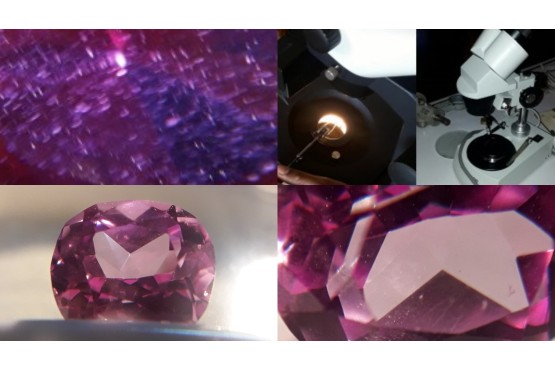Even I Got Tricked — What a Fake Pink Sapphire in Madagascar Taught Me About Real Value
-
-
<p>June 02, 2025<br />
<br />
In 2002, I Got Tricked — Here’s the Story, Straight from the Mine in Madagascar<br />
<br />
Not every gemstone loss is visible. Some look beautiful. Some come with certificates. Some fool you twice — once when you buy and again when you realize you can’t sell.<br />
<br />
I bought a beautiful rough pink sapphire early in my career, only to later discover it was synthetic. I had been overly confident. The color was perfect. The clarity was mesmerizing. And it came straight from a dusty miner's palm. But it was too perfect. I examined it again and again. Even under my 30x loupe — clean. Too clean to believe. That mistake taught me one of the most valuable lessons of my 27-year field career:<br />
<br />
🧠 Some things can't be learned in school. Not at GIA. Not even at Harvard. I paid handsomely for that stone… and the education it came with.<br />
<br />
<b>The Moment of Truth</b><br />
<br />
The realization hit me three weeks later, back in a gem lab in Bangkok. I was preparing the stone for certification when something felt off. The internal structure was too uniform, too pristine. Natural sapphires from Madagascar carry the scars of their billion-year journey — tiny inclusions that tell their geological story. This stone had no story.<br />
<br />
When the spectrometer results came back, my heart sank. Flame-fusion synthetic. Created in a laboratory, not deep in the earth's crust. The miner who sold it to me probably didn't even know — synthetic rough stones were flooding the Madagascar market, mixed deliberately with natural specimens to fool even experienced buyers.<br />
<br />
<b>The Expensive Education</b><br />
<br />
That single stone cost me $8,000. But the lesson it taught me was worth ten times that amount. I learned that confidence without experience is dangerous. I learned that even legitimate mining sites can harbor deception. Most importantly, I learned that my eyes — no matter how trained — could be fooled by increasingly sophisticated synthetics.<br />
<br />
Developing Real-World Detection Skills 💼 Today, everything I source — whether it’s a Madagascar ruby, a Colombian emerald, or a Sri Lanka Sapphire — is evaluated with one key question: What happens when we sell? I carry my loupe with me everywhere. My motto?<br />
<br />
<b>"If I see no noise through my 30x loupe — you can keep it. I won't buy."</b><br />
<br />
But it goes deeper than just looking for inclusions. Over the years, I've developed what I call "field intuition"—a" combination of technical knowledge and gut instinct that can only come from handling thousands of stones in real-world conditions.<br />
<br />
<b>The Three-Touch Test</b><br />
<br />
I now use a systematic approach I developed after that Madagascar incident:<br />
<br />
Touch 1: The Weight Test — Natural stones have subtle density variations. Synthetics often feel slightly "wrong" in your palm, though it takes years to develop sensitivity for this.<br />
<br />
Touch 2: The Temperature Response — Natural gemstones conduct heat differently than their synthetic counterparts. I'll hold a stone against my upper lip for exactly five seconds — the upper lip is incredibly sensitive to temperature variations. The subtle temperature difference often reveals more than visual inspection alone.<br />
<br />
Touch 3: The Surface Texture — Here's a field trick I discovered by accident: if you rub a synthetic sapphire on a microfiber cloth, it feels very slightly rubbery. Natural stones don't have this characteristic. It's subtle, but once you know what to feel for, it becomes unmistakable.<br />
<br />
<b>Beyond the Classroom Knowledge</b> This type of field-earned knowledge isn't written in books. You won't find it on YouTube. And no lab will hand it to you in a certificate.<br />
<br />
The gemstone investment world is filled with academic knowledge that stops short of practical application. Traditional education teaches you about crystal structures, optical properties, and market theory. But it doesn't prepare you for the moment when a desperate miner offers you a "once-in-a-lifetime" stone at 3 AM in a remote village where the nearest gemological lab is 500 miles away.<br />
<br />
<b>The Hidden Costs of Learning the Hard Way</b><br />
<br />
My Madagascar mistake was just the beginning. Over my 27-year career, the tuition to this school of hard knocks has been substantial — each expensive lesson teaching me something that no textbook could convey:<br />
<br />
How to spot heat treatment that wasn't disclosed<br />
<br />
Why certain "rare" varieties suddenly flood the market<br />
<br />
How political instability affects gemstone supply chains<br />
<br />
When to walk away from deals that seem too good to be true<br />
<br />
The cumulative cost of these field lessons? Let's just say it could have bought a very nice house. But each mistake became invaluable knowledge that protected me from far larger losses down the road.<br />
<br />
🔹 Four Strategic Pillars Built in the Field — Not in Theory What I share today isn’t a sales funnel. It’s field-won strategy.<br />
<br />
These four strategic pillars weren’t developed in a seminar or copied from investment playbooks — they were forged through:<br />
<br />
847 mining site visits across 23 countries<br />
<br />
$2.3 million in direct gemstone investment<br />
<br />
Long-term trust with miners, cutters, and buyers across multiple continents Lessons paid for in mistakes and recovered in method<br />
<br />
These are the frameworks that now guide every sourcing trip, acquisition decision, and investor partnership I take on:<br />
<br />
Pillar 1: The Authentication Protocol A multi-layered verification approach developed after a costly Madagascar purchase — refined through hundreds of field transactions. It’s how I trust stones beyond certificates.<br />
<br />
Pillar 2: The Market Timing Matrix A real-time lens on how geopolitical shifts, mine closures, and collector cycles affect price velocity — and how we use that to acquire before appreciation.<br />
<br />
Pillar 3: The Network Navigation System Years of sorting out who stands behind their stones — and who vanishes after the sale. This system filters who I trust to source from and who never gets a second deal.<br />
<br />
Pillar 4: The Exit Strategy Framework Buying well is half the work. Selling right — at the right time, to the right hands — is where quiet profit is made. This includes emotional nuance and the logistical chess of high-value liquidation.<br />
<br />
The Real Value of Hard-Won Experience Every expensive mistake in my career represents knowledge that protected me from larger losses later. The $8,000 Madagascar sapphire was my wake-up call, but it was far from my last costly lesson.<br />
<br />
Over the years, those "education fees" accumulated — heat-treated rubies sold as natural, perfectly color-matched emerald sets that turned out to be assembled stones, and rare Padparadscha sapphires that weren't actually from Sri Lanka. Each disappointment added to my field education.<br />
<br />
When you invest in gemstones based on book knowledge alone, you're essentially gambling with expensive tuition ahead of you. When you invest with battle-tested experience, you're making calculated decisions backed by real-world data.<br />
<br />
The difference between the two approaches often determines whether gemstone investing becomes a profitable passion or an expensive hobby.<br />
<br />
📩 Ready to benefit from 27 years of frontline gemstone investing?<br />
<br />
<b>What You Can Do Now — Without Repeating My Mistake</b><br />
<br />
The synthetic pink sapphire I misjudged cost me more than money — it taught me how easily even experienced buyers can be misled when speed outruns structure.<br />
<br />
You don’t need to learn the same way I did. Whether you’re here to buy, invest, explore, or simply prepare for a future move:<br />
<br />
🔹 Strategic Investment Form My strategic investors don’t just pick stones. They define the resale window, certification preferences, capital structure, and timing. We plan before we acquire — so they don’t end up holding something beautiful but immobile.<br />
<br />
If you’re thinking in capital terms — not jewelry terms — this is where you begin:<br />
<br />
→ <a href="https://gemwealth.store/StrategicInvestmentForm.html">Submit your strategy here</a><br />
<br />
If you’re not investing strategically but still want to be involved — whether as a direct buyer, a remote sourcing participant, or someone just exploring — I’ve outlined other ways to begin. Each one is based on what you want, not what I’m trying to sell.<br />
<br />
🔗 <a href="https://www.gemwealth.store/gemstone-investment-scenarios.html">Explore Scenarios</a><br />
<br />
🔗 <a href="https://www.gemwealth.store/FieldNotes-Blog.html">Learn How Fieldtrip Sourcing Works</a><br />
<br />
A mistake made once is tuition. A mistake repeated is a strategy failure. I don’t repeat that one.<br />
<br />
#GemstoneInvesting #MadagascarSapphire #GemstoneFieldwork #Sapphire #InvestorEducation #RealAssets #WealthStrategy #FieldExperience #GemAuthentication</p>

